Transduction of envelope stress in Escherichia coli by the Cpx two-component system
Type
Disruption of normal protein trafficking in the Escherichia coli cell envelope (inner membrane, periplasm, outer membrane) can activate two parallel, but distinct, signal transduction pathways. This activation stimulates the expression of a number of genes whose products function to fold or degrade the mislocalized proteins. One of these signal transduction pathways is a two-component regulatory system comprised of the histidine kinase CpxA and the response regulator, CpxR. In this study we characterized gain-of-function Cpx* mutants in order to learn more about Cpx signal transduction. Sequencing demonstrated that the cpx* mutations cluster in either the periplasmic, the transmembrane, or the H-box domain of CpxA. Intriguingly, most of the periplasmic cpx* gain-of-function mutations cluster in the central region of this domain, and one encodes a deletion of 32 amino acids. Strains harboring these mutations are rendered insensitive to a normally activating signal. In vivo and in vitro characterization of maltose-binding-protein fusions between the wild-type CpxA and a representative cpx* mutant, CpxA101, showed that the mutant CpxA is altered in phosphotransfer reactions with CpxR. Specifically, while both CpxA and CpxA101 function as autokinases and CpxR kinases, CpxA101 is devoid of a CpxR-P phosphatase activity normally present in the wild-type protein. Taken together, the data support a model for Cpx-mediated signal transduction in which the kinase/phosphatase ratio is elevated by stress. Further, the sequence and phenotypes of periplasmic cpx* mutations suggest that interactions with a periplasmic signaling molecule may normally dictate a decreased kinase/phosphatase ratio under nonstress conditions.

